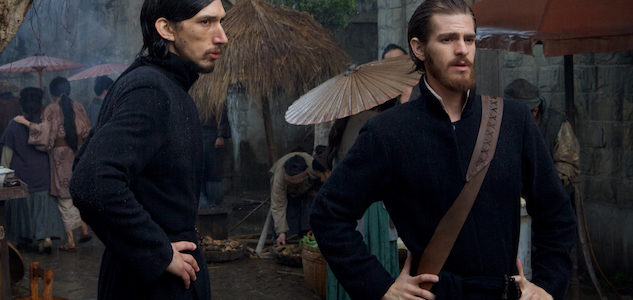
ReelBob: ‘Silence’
By Bob Bloom
Truly devout people listen for the word of God in their hearts or heads. As they wait, a silence envelops them, making them feel closer to their Creator or Savior.
This faith, this unshakable and resolute belief in a divine presence, is at the center of “Silence,” director Martin Scorsese’s latest foray into how religion shapes a person, a people and a nation.
The film, co-written by Jay Cocks and Scorsese and based on a 1966 novel  by Japanese author Shusako Endo, is set in 17th-century Japan when, Jesuit priests were roaming the country spreading the word of Christ and converting thousands of Japanese to Christianity.
by Japanese author Shusako Endo, is set in 17th-century Japan when, Jesuit priests were roaming the country spreading the word of Christ and converting thousands of Japanese to Christianity.
Japan’s rulers quickly retaliated, outlawing the religion, killing and torturing priests and brutally coercing many of them to publicly denounce their faith.
Two Jesuit missionaries from Portugal, Father Rodriques (Andrew Garfield) and Father Francisco Garupe (Adam Driver), sneak into the country to find their mentor, Father Ferreira (Liam Neeson), whom rumors say has repudiated his faith and adapted a Japanese lifestyle.
The two, young idealistic Jesuits are determined to prove these stories are lies by finding Ferreira and learning the truth directly from him.
What they find, instead, is a closed society where frightened Japanese peasants practice their Christianity in secret and, if discovered, are persecuted, tortured or killed.
Despite the danger, these simple villagers welcome the two “padres” as signs that God has not abandoned them.
“Silence” is a slow meditation about the challenge and limits of faith. At times, the film feels like a theological debate, yet Scorsese creates an environment that takes you not only inside a feudal society, but into the souls of the Jesuits, especially Rodriques.
While Garupe remains in a friendly village to tend to its faithful, Rodriques seeks out Ferreira.
Rodriques is eventually betrayed and captured. His convictions are severely tested as he watches converts tortured and killed because he refuses to abandon his faith — even if, as told by his captors, it is an insincere gesture.
Garfield’s quiet performance masks a pride and arrogance for which many others must suffer. Rodriques’ Western hubris is no match for the patience and persistence of his Japanese inquisitors, especially Issey Ogata as Inoue, whose mental mistreatment of the priest is as brutal as the physical punishment inflicted on the peasants.
Like the priests at the film’s outset, Japan is a mystery, obscured by clouds or fog. As the story advances, and Rodriques and Garupe learn more about the country and its people, Scorsese and cinematographer Rodrigo Prieto reveal more of the landscape.
“Silence” slogs along at times, but its whole is so much greater than its parts.
The film is a thoughtful — sometimes brutal — treatise on religion, conviction and the power — and consequences — of blind faith.
Bob Bloom is a member of the Indiana Film Journalists Association. His reviews appear at ReelBob (reelbob.com) and Rottentomatoes (www.rottentomatoes.com). He also reviews Blu-rays and DVDs. He can be reached by email at bobbloomjc@gmail.com or on Twitter @ReelBobBloom.
SILENCE
3½ stars out of 4
(R), graphic violence, disturbing content